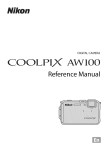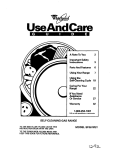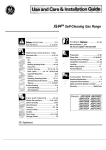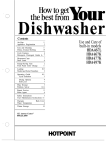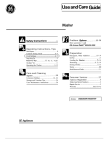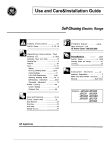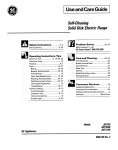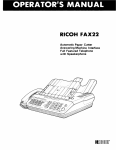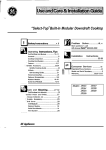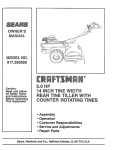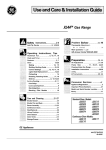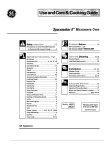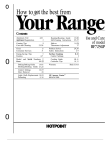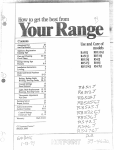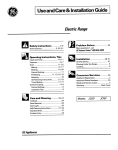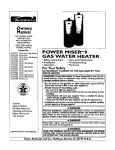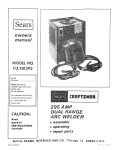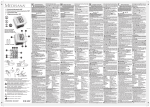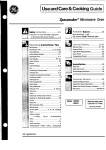Download GE JGAS02EN User's Manual
Transcript
“ ‘ Gas Range Safe* Instrudons....................2-5 Anti-Tip Deviw .............................2, 3, 19,28 Operating Instructions, Ttps Aluminum Foil ............................5, 14, 16, 17 Features ............................................................7 Flooring/Leveling ...........................................6 @en.. . . . . . . . . . . . . . . . . . . . . . . . . . . . . . . . . . . . . . . . . . . . . . . . . . . . . . . . l&18 Baking . . . . . . . . . . . . . . . . . . . . . . . . . . . . . . . . . . . . . . . . . . . . . . . . . . 13, 14 Broiling, Broiling Guide...........,.........l7,18 Oven Control . . . . . . . . . . . . . . . . . . . . . . . . . . . . . . . . . . . . . . . . . . . . . . 10 Roasting, Roast;ng Guide................l5, 16 Shelves . . . . . . . . . . . . . . . . . . . . . . . . . . . . . . . . . . . . . . . . . . . . . . . . . 11, 13 Sutiace Cooking.........................................8,9 ControlSettings..........................................8 ElectricIgnition.......................................8,9 Care and Cleaning ....................l 9-24 Broiler Pan and Rack..........................................22 Burner .mbW........... . . . . . . . . . . . . . . . . . . . . . . . . . . . . . . 19-21 Coomp ..........................................................2 1 Door Removal ......................:........,...............23 @en'.~~orn.................................................22 ~~Oj-lejD~~w6r, .,. . . . . . . . . . . . . . . . . . . . ... . . . . . . . . . . . . . . . . . . . . 22 . . ,. Problem Solver. ..............................34 Thermostat AdjustmentDo It Yourself. . . . . . . . . . . . . . . . . . . . . . . . . . . . . . . . . . . . . . . . . 12 More questions ?...call GEAnswer Cente~ 80~626.2000 consumer Services ...................36 Appliance Registration..................................2 Imponant Phone Numbers .......................36 Model and Serial Number Location ...........2 Warranw ......................,.................Back Cover Models: JGAS02PN JGAS02EN JMS02PN =LP US ~LP YOU Read this book carefdy. ~ you received a damaged rarige... It is intended to help you operate and maintain your new range properly. Keep it handy for answers to your questions. If you don’t understmd something or need more help, write (include your phone number): Consumer Affairs GE Appliances Appliance Park Louisville, KY 40225 tiediately contict the alder (or builder) that sold you the range. Write dom the model and serial numbers. You’ll find the model and senrd numbers on two labels on the range front frame near the broiler drawer. These numbers are dso on the Consumer Product Ownership Registration Card that came with your range. Before sending in this card, please write these numbers here: Save time and money. Before you requ=t service... Check the Problem Solver in tie back of this book. It lists causes of minor operating problems that you cm correct yourself. @ a h4 @m’Mn A WAWNG ALL RANGES CAN TW. INmRY TO PERSONS w COULD RESULT. ~STALL THE ANTI-TW DEVICE PAC~D WITH b, THE RANGE. SEE THE ~STALLATION @ ~STRUCTIONS. ● ● ● Model Number Setial Number Use these numbers in any correspondence or service calls concerning your range. ● ~ YOU ~ED SERWCE To obtain service, see the Consumer Services page in the back of this book. To obtain replacement parts, contact G~otpoint Service Centers. We’re proud of our service and want you to be pleased. If for some reason you are not happy with the service you receive, here are three steps to follow for further help. HRST, contact the people who serviced your appliance. Explain why you are not pleased. In most cases, this will solve the problem. NEXT, if you are sti~ not pleased, write dl the details-including your phone number—to: Manager, Consumer Relations GE Appliances Appliance Park Louisville, KY 40225 ~ALLY, if your problem is still not resolved, write: Major Appliance Consumer Action Panel 20 North Wacker Wve Chicago, ~ 60606 ., . WAHG: Mthe information in this mand is not fotiowed emctiy, a fire or e~losion may At musing property damage, persod tijury or dmth. —Do not store or use gasotie or other flammable vapors and Mquids in the vicinity of this or any other apptiance. —WHAT TO DO ~ YOU S~LL GAS Do not try to tight any apptie. Do not touch any el~trid swikh; do not use any phone in your btiding. ● ● -ediately d your gas suppher from a neighbor’s phone. FOUOW the gas supptier’s instructions. c M you mot mch your gas supptier, ~ the fw department —btiation and service must be performed by a qtiled Mer, service agency or the gas supptier. ● WORTW S~TY NO~CE The Mornia Safe Brirddng Water M Tom Enforcement Act requires the Governor of pa- mated* are removed from the range before operating it to~vent * or Q Be m W ● ● C~ornia to pubtishatist of substances hownto the state to cause canmr, birth clef* or other reproductive harm, and requires businesses to warn customers ofpotenthd exposure to such substanm. Gas apptim can muse minor exposw to four of tiese substances, namely beme, carbon monotide, formaldehyde and soog caused primdy by the incomplete combustion of nati gas or LP hels, Properly adjusted burners, indicated by a bluish rather b a yeflow flame, m~ incomplete combustion. &posm to thes6’subs~ces canbe . “ “@by vendng with an open window or using a ventilation fan or hood. ~enYou &t Yom -e Have the Mer sbow you fie location of the qe w at-off vdveti how toshutit off Mnecessary. Have yon -e Wed and pro~rly grounded by a q-cd Mer, in accordanm with the kstiation ktructions. Any adjustment ● ● smoke damage shotid the packing material ignite. Be sure your range is co-y adjusted by a q-cd servim t-cian or ~for the type of ~ (uati or.W)thatis to be used. ● Your range can be converted for use with either type of gas. Seethe btiation kstructions. W-G: These adjustments must be made by a ~dified serviee tihnician in accordance with the manufactir’s instructions and W codes and requirements of the authority having jurisdiction. Failure tofo~ow these instructions codd resdt in setious injury or property damage. The q~ed agency performing this work assumes responsibtity for the conversion *After prolonged w ofa _ ~ kr ~peram may wtit and many floor #V~ti& @ not tihd ~ Md of m Never @til b range over vinyl tie or holerun that cannot withstand such type of use, Never instil it -y over interior kitchen carpeting. ● and service shotid be perfomed o~y by q-cd gas range instiers or service *hrdcians. ● Phg your ~~ into a l~volt ~unded outie$ dy. Do not remove tbe round grountig prong bmthe plug. Ein doubt about the grounding of the home electrid system it is yom personal respomibfity and ~tigation to have m ungrounded outiet repl* with a properly grounm-prong outiet in accordance witb the Nstiti MectridCode. h C- the apphana must be electri@y @unded in accordance with the Ctian M=trical. Code. Do not use an extension cord with this app~an%. Q Do not zttempt to _ or rephee ay partofyourrange urdessittispecifi*y recommended & M @da M other servicing shodd be referred to a q~ed tecMcian. Q -te _ out of Mtien tic pati and out of - btiow to prevat pnot OU* (onstanding@ot rnod~) and poor air *tiom WAmNG–M_ m tipand~~atit ~ prev@nt8WidenM@pingof the ~% ~h~ approved ~ti-~q @ device to tie wW. (SW kstiation hstructions.) To chd if the device is in- and engaged properly, care~y tip tie range forward, The @ Anti-Tip device shotid engage and prevent therauge from tipping over. Hyoupdl the range out from the wd for any reaso~ make sw the Anti-Tip device is engaged when you push the range back agtist the wW. Hit is not there is a possible risk of the range tipping over if you or a c~d stan~ sit or lean on an open door. 3 ● ● ● ● ● Do not leave Mdren #one or unattended where a range is hot or in operatia They cordd be seriously burned, Do not Uow anyone to ebb, stand or hang on the door, brotierdrawer or range top. They cordd damage the range and even tip it over, causing severe perso~ ~~. Ut burner grab and other surfam cool before tonctig them or leaving them where Mdren can reaeh them. Never wear loose fitig or hanging garments whtie wing the apptian% Be careti when reaching for items stored in Mbinets over the cooktop. H_le rnaterhd codd be ignited if brought in contact witi tie or hot oven sti~~s and may cause severe burns. For your safety, never use your apphce for we or heating the room. e Do not m water on grease m. Never pickup ating pan. Turn off e burner, then smotberfbuning p~. by wvering pan mmpletely with wefl-fitting HA cookie sheet or fiat tray. Haming -e outside a pan can be put out by covering with baking soda or, if avdable, a muki-purpose dry chemical or foam-type fix extinguisher. * Do not store tible rnaterkds in an oven> a range brotier drawer or near a cooktop. s Do not store or use combmtihle materkds$ gasotineor other fhunmablevapors and tiquids in the victity of this or any other app~anee. s Do not let cooking grease ar other tible materkds ac-tite h or near the range. men coo- pork$ follow thedirections ● exacdy and always cook the meat to an internal temper- of at least 170°F. This assures M4 k the remote possibfity that trichina may be pment in the meat, it til be ki~ed and the meat W be safe to eat 4 Stiace CMQ Always w the L~ position (on electic ignition rnodek) or the ~ position (on standing pflot modek) when igniting top burners and ● ● ● make sw the burnem have ignited. Never leave tiace burners unattended at Mgh tie settings. Boilovercauses smoking and greasy spi~overs that may catch on fie. Adjust the top burner flame* so it does not e~nd beyond the edge of the cookware. Excessive flame is Wardous. o Use O* dry pot holde-moist or damp potholders on hot surfaces may resuk in burns from steam. Do not let pot holders come near open flames when ~g cookware. Do not use a towel orotherb@ cloth in place of a pot holder. ● To ~ the possibtity of burns, ignition of flmable materials, and $pWge, turn cookware hmdes toward the side or back of the range without extending over adjacent burners. Always b the stiaee burner to 0~ before removing the cookware. “ CareMy wati foods being fried at a high flame setting. Never blti the venb (tir openings) of the rangk They provide the h Met and outiet that ● ● ● are necessary for the mge to operate properly with corrwt combustion. W openings are located at.the rear of the cooktop, at tie top and bottom of the oven door, and at the bottom of the range mder the broiler drawer. ~ not use a wok on modeh with -ed burners Uthe wok has a round mettd ring that is phced over the burner grate to snpport the wok. This ring acts as a heat #p, which may damage the burner grate and buraer head. Aso, it may cause tie burner to work @properly. This may cause a carbon monofide level above that Wowed by current standards, resdtig in a heakh -. ● Foods for- shotid be as dry as possible Frost on tiomn foods or moisture on fresh foods can cause hot fat to bubble up and over sides of the pan. ● ● ● Use least possible am-t of fat for effective shtiow or deepfat =. Filhg the pan too W of fat can cause spflovers when food is added. Ka cornbtiation of & or fa~ ~ be used k f-, stir together before heating or as fats melt #owly. Use a deep fat thermometer whenever possible to prevent overheating tit beyoudthe Smotig point. *Use proper ~ &Avoidpms that are uustable ● or dy tip Sel@ mkware hatig U bottoms & 6nough to properly contain food and avoid botiovers and sptiovers and ~e mou@ to cover burner grate. ~s W both save cleaning time nd prevent =ous accmmdatiom aff~ since heavy s-g or spMovers left on range can ignite. Use pans with han~es that can be easfly wm and remain cool, men X - cookware, make snre it is designed for top-of-range cooking. amen - foods are mder the hood, turn the fan off. me f- ifoperatig, may spread the ti~ c W mge & located near a fidow, do not hang long curtains that codd blow over the top burners and create afire h-. *men a ptiot gw out (on s~ding @ot models), you til detwt a faint odor of gas as your sigmd toretight the pfi~t. men refighting the ptio~ make snre burner controk are in the Om position, and fo~ow instructions in this book to re~ght. Hyou smM gas, and you have hdy made sure pdots me tit (on staatig pilot models), turn off the gas to W mge and eti a qualified service t~hnician. Never use an open flame to ~ate a leak. ● cl- Yow -e Clean ody parts M k W Use =d ~re Nde. ~ Keep_ d-and k of aeeumrdations of - or spWoVem which my @k * W mti when you clean the cooktop because ● . Keep fl p~es away from top buraers. * M not leave pktic i- on the cooktop they may melt if left too close to the vent, M not bve ~ items @n the eooktop. me hot ● air from the vent may ignite tible items and ● til inmepresswin closed containers, which may canse them to burs~ To avoid the possibtity ofa bum akways be certain that the controb for ~ bmers are at the OFF petition and W grates are-before attemp~ to remove them. 5 Your range, tike many other household items, is hwvy and can settle into soft floor coverings such as cushioned vinyl or arpeting. men moving the range on this type of flooring, use care, and it is recommended that these simple instructions be followed. The range should be instiled on a l/4-inch thick sheet of plywood (or similar materird) as fo~ows: men the floor covering ends at the front of the range, the area that the range wi~ rest on should be built up with plywood to the same level or higher than the floor covering. This wfll tiow the range to be moved for cleaning or servicing. Leveling legs are located on each corner of the base of the range. Your range must be level in order to produce proper cooking and baking results. Merit is in its find location, place a level horizontily on any oven shelf and check the levelness front to back and side to side. Level the rmge by adjusting the leveling legs or by placing shims under the comers as needed. One of the rear leveling legs will engage the hti-Tip device (allow for some side to side adjustment). Mlow a minimum clearance of 1/8 inch between the range and the levehng leg that is to be instrdled into the hti-Tip device. 6 Y I + Shnding Pilot Models JGAS02PN \ JLAS02PN Electtic Ignition Model JGAS02EN Fwture hdex 1 Anti-Tip Device (see Safe~ hstructions) Explained on page Feature hdex Expltied on page 3,5 7 Cooktop 14 8 OVEN TEMP Mob 9 9 Oven SheHSuppoti Shelf positions for coobg are suggested in the Baking, Roasting and Broiling pages. 9 2 Model and Serbd Number 2 3 Removable Oven Bottom 16 4 Sutiace Burner Controk 7 5 Oven Vent (located in center of rear of range) 9 6 Sutiace Bumem and Gratin 14, 15, 17 10 Oven Shelv~ tith Stop-bcks 9, 15, 17 11 Brotier Pan and Rack 13, 15, 17 7 SMACE COO~G Lighting Instructions for Electric Ignition Models JGAS02EN The surface burners on some models me lighted by electric ignition, eliminating the need for standing pilot lights witi constandv- burning flames. In me of a power failure, you can light the surface burners on your range with a match. Hold a hghted match to the burner, then turn the knob to the L~ msition. Use extreme mution when ti~hti burners -hs way. Surface burners in use when an electrical power failure occurs will continue to operate normally. The electrode of the spark igniter is exposed. men one burner is turned to LITE, W tie burners spark. Do not attempt to disassemble or clean around any burner while another burner is on. An electric shock may result, which could cause you to knock over hot cookware. I I Lighting Instructions for Standing mot Models JGAS02PN, JLAS02PN pilot adjustment The surface burners on these ranges have standing pilots that must be tit initially. To light them: 1. Be sure surface burner control knobs are in the 0~ position. 2. Remove the grates and lift the cooktop up (see the Cooktop section). screw pilot tubes 4 \& 2 pilot filter manifold 7 manifold% pipe panel 4. If 3. Locate the 2 pilot ports ad light each of them with a match. the pilots need adjusting, turn the adjusting screw located on the pilot filter. 5. Lower the cooktop. Your surface burners are now ready for use. 6. Observe lighted burners. Compare the flames to pictures in the Problem Solver. If any flame is unsatisfactory, crdl for service. Surface Burner Controls Before Lighting a Burner The knobs that turn the surface burners on and off are located on the control panel on the front of the range. The two knobs on the left control the lefi front and left rear burners. The two knobs on the right control the right front and right rear burners. If drip pans are supplied with your range, they should be used at dl times. ● Make sure dl the grates on the range are in place before using any burner. 8 ● To Light a Surface Burner After Lighting a Burner Electric Ignition Modeh: ~h the control hob in and tumittoLITE.Youwillhem ~1111 a litde “clicking” noise—the sound of the electric spark igniting the burner. Standing Hlot Model: Wsh control knob in and turn P it to HI position. The burner should light within a few seconds. After the burner ignites, turn the knob to adjust tie flame size. ● Check to be sure the burner you turned on is the one you want to use. ● Do not operate a burner for an extended period of time without cookware on the grate. The finish on the grate may chip without cookware to absorb the heat. ● Be sure the burners and grates are cool before you place your hand, a pot holder, cleaning cloths or other matends on them. ● Air Adjw@ent An air adjustment shutter for each surface burner regulates the flow of air to the flame. When the right amount of air flows into the burner, the flame will be steady, relatively quiet and have approximately 3/4-inch sharp blue cones. This is usually the case with factory preset shutter settings. With too much air, the flame will be unsteady, possibly won’t burn rdl the way around, and will be noisy, sounding like a blowtorch. With not enough air, you won’t see any sharp blue cones in the flame, you may see yellow tips and soot may accumulate on pots and pans. To adjust the flow of air to the burners, rotate the shutters to allow more or less air into the burner tubes as needed. How to Select Name Sbe Watch the flame, not the knob, as you reduce heat. The flame size on a gas burner should match the cookw~e you are using. FOR SAFE WL~G OF COOKWARE ~WR LET THE FLAME EKTE~ W ~ S~ES OF ~ COOKW~. Any flame larger than the bottom of the cookware is wasted and ordy serves to heat the hande. Top of Range Cookware Almnin um: Medium-weight cookware is recommended because it heats quictiy and evenly. Most foods brown evenly in an durrdnum stiet. Use saucepans with tight-fitting tids when cooking with minimum amounts of water. Cast-iron: If heated slowly, most skillets will give satisfactory results. Enamelware: Un&r some conditions, the enamel of some cookware may melt. Follow cookware manufacturer’s recommendations for cooking methods. Glass: There are 2 types of glass cookware-those for oven use ody and those for top-of-rmge cooking (saucepans, coffee and teapots). Glass conducts heat very slowly. Hwtproof Gks Ceramic: Can be used for either surface or oven cooking. It conducts heat very slowly and cools very slowly. Check cookware manufacturer’s directions to be sure it can be used on gas ranges. Stahdess Steel: This meti done has poor heating properties and is usually combined with copper, aluminum or other metis for improved heat distribution. Combination meti skillets usually work satisfactorily if they are used with medium heat as the manufacturer recommends. 9 Before Using Your Oven Be sure you understand how to set the controls properly. Practice removing and replacing the shelves while the oven is cool. Read the information and tips on the following pages. Keep this book handy where you can refer to it, especially during the fwst weeks of using your new range. Lighting Instructions for Electric Ignition Model JGAS02EN The oven burner on ti range is tighted by electric ignition. To tight the burner, turn the OVEN TEMP knob to the desired temperature. The burner should fight within 30-90 seconds. After the oven reaches the selected temperature the oven burner cycles on and off to maintain the selected temperature. Power Outige A burner in use when an electricrd power failure occurs wdl continue to operate normally. Your oven may be used during an electrical power outige by carefully following the steps below: To tight the oven ptiot during an electrid power outage: 1. Be sure the OVEN TEMP knob is in the OFF position. 2. Open both the oven and broiler doors and wait 5 minutes to allow any pilot gas to dissipate. 3. Unplug the range from the wdl outiet, turn off the circuit breaker, or remove the fuse to avoid accidenti ignition of the oven if electrical power is restored wtie you are lighting the pflot. 4. Remove the broiler pan. 5. Locate the oven pilot assembly by looking into the broiler opening. The pilot is at the back of the broiler compartment, on the right side of the burner. NOTE: The oven must beat room temperature before you should attempt to light the oven pilot manually. 6. Turn the OVEN TEMP knob to the desired temperature setting. 7. Light the pilot with a match and withdraw your arm immediately because the oven burner may light in as litie as 20 seconds. 8. Replace the broiler pan and close the oven and broiler doors. NOTE: It is necessary to light the pilot manually each time the oven is used during a power outage. Lighting htructions for Stiding mot Models JGAS02PN, JLAS02PN These ranges have standing oven pilots that must be lit initially. To light the oven pilot: 1. Be sure the OVEN TEMP knob is in the OFF position. 2. Remove the oven bottom and the burner btie. See the Care and Cleaning section. 3. Find the oven pilot port at the back of the oven. 10 4. Using a long match or match holder, reach in and tight the oven pilot. 5. Place the burner btie and the oven bottom and cIose the door. Your oven and broiler are now ready for use. ● To light the oven burner, turn the OVEN TEMP bob to the desired temperature. The burner should light within 60 seconds. ● Power faflure? An electrical power failure will not affect the standing oven pilot. Oven Control Your oven is controlled by an OWN TE~ knob. It will norrndly take 30-90 seconds before the flame comes on. Air Adjw@ent / & An air adjustment shutter for the .,’ — ,.’.oven burner ,.. ... regulates the flow of air to the flame. You’ll find the Loosen ‘+ shutter against the / back wdl behind Air adjustment the broiler drawer. shutter To reach it remove ti the oven bottom (see the Care and Cleaning section) and the burner btie. After the oven reaches the selected temperature, the oven burner cycles+ff completely, then on with a full flame-to maintain the selected temperature. To adjust the flow of tir, loosen the Philhps head screw and rotate the shutter to allow more or less air into the burner tube as needed. men the tight amount of Ar flows kto the burner, the flame should be steady, with approximately 1/2 inch blue cones, and should not extend out over the btie edges. Oven Shelves The shelves are des~ed tith stop-lock so when placed correctly on the sheM suppo~, they till stop before co~ng completely out of the oven and fi not tit when you are remotig food from them or plachg food on them. men placing cookware on a shelf, pull the shelf out to the “stop” position. Place the cookwme on the shelf, then slide the shelf back into the oven. This will elimimte reaching into the hot oven. To remove a sheti from the oven, pull 6 it toward you, tit -1 the front end upward and pull 1- Iill * the shelf out. To replace, place the shelf on the shelf support with the top-locks (curved extension of the shel~ facing up and toward the rear of the oven. Tilt up the front and push the shelf toward the back of the oven until it goes past “stop” on the oven wall. Then lower the front of the shelf and push it dl the way back. SheM Positions The oven has 4 she~ supports for normal baking and roasting identified in this illustration as A ~ottom), B, C, D (top). Shelf positions for cooking are suggested on the Baking, Broiling and Roasting pages. (continued ne~page) 11 USmG YOUR O~N (continued) Oven Vents The oven is vented tiough duct openings at the rear of the cooktop. See the Features section. Do not block the opening when cooking in the oven—it is important that the flow of hot air from the oven and fresh air to the oven burner be uninterrupted. ● The vent openings and n-rby surfaces may become hot during baking and brofing. Do not touch them. ● Do not leave plastic items on the cooktop they may meit if left too close to the vent. Handles of pots and pans on the cooktop may become hot if left too close to the vent. ● Meti items til become very hot if they are left on the cooktop and codd ause burns. ● Do not leave any items on the cooktop. The hot air from the vent may ignite flammable items and will increase pressure in closed containers, which may cause them to burst. ● Do Zt Yourse~—Adjmt the Oven Themosbt ffyou don’t think the oven is heating at the right temperature when you are baking or roasting, you m reset the thermostat yourseM. When cooking food for the f~st time in your new oven, use time given on recipes as a guide. Oven thermostats, over a period of years, may “drift” from the factory setting and the differences in timing between an old and a new oven of 5 to 10 minutes are not unusual. Your oven has been set correctiy at the factory and is more likely to be accurate than the oven which it replaced. We do not recommend the use of inexpensive thermometers, such as those found in the grocery store, to check the temperature setting of your new oven. These thermometers can vary by 2M0 degrees. To decide how much to change the temperature, set the oven temperature 25°F. higher or lower than the temperature in your recipe, then bake. The results of this “test” should give you an idea of how much the temperature should be changed. Note ~sition of Winter to marks before adjustment. ~fl-~ %4 @ L P&@’ , @ ● ao ~\ Loosen only the locking screws. Note to which mmk the pointer is pointing. To make an adjustment carefully loosen (approximately one turn), but do not completely remove the two screws that hold the skin to the knob. Hold the knob blade in one hand and the outer skirt in the other hand. To raise the oven temperature, move the pointer in the direction of the arrow for MSE. To lower the temperature, move the pointer in the direction of arrow for LOWER. Each mark WW change the oven temperature approximately 25°F. We suggest that you make tie adjustment one mark from the original setting and check oven performance before making any additiond adjustments. After the adjustment is made, press skirt and knob together and retighten screws so they are snug, but be careful not to overtighten. Re-instil knob on range and check performance. NO~: -ran adjustment has been made, the OFF and BROL positions wi~ not tie up with the indicator mark on the control panel as they previously did. This condition is normal and wi~ not create a problem. How to Set Your Range For Bating To avoid possible bum, place the shelves in the correct position before you turn on the oven. 1. Close the oven door. Then turn the OVEN ~MP knob to the desired temperature. 2. Check the food for doneness at the minimum time on the recipe. Cook longer if necessary. Turn the OVEN ~MP knob to OFF and remove the food. For best baking results, follow these suggestions: Oven Shelves Arrange the oven shelf or shelves in the desired locations while the oven is cool. The correct shelf position depends on the kind of food and the browning desired. As a general rule, place-most foods in the tiddle of the oven, on either the shelf position B or C. See the chart for suggested shelf positions. ] Type of Food ] SheEPositio” Angel food cake A Biscuits or muffins B or C Cooties or cu~akes B or C Brownies B or C Layer cakes B or C Bundt or pound cakes A or B Pies or pie shells B or C Frozen pies A (on cookie sheet) I Casseroles I BorC Preheating Reheat the oven if the recipe cds for it. Preheat means bringing the oven up to the specified temperature before putting in the food. To preheat, set the oven at the correct temperature-selecting a higher temperature does not shorten the preheat time. Preheating is necessary for good results when baking cakes, cookies, pastry and breads. For most casseroles and roasts, preheating is not necessary. For ovens without a preheat indicator light or tone, preheat 10 minutes. After the oven is preheated place the food in the oven as quic~y as possible to prevent heat from escaping. BaKng Pans Pan Placement Use the proper baking pan. The type of ftish on the pan determines the amount of browning that wfll occur. ● Dark, rough or dull pans absorb heat resulting in a browner, crisper crust. Use this type for pies. ● Shiny, bright rmd smooth pans reflect heat, resulting in a lighter, more delicate browning. Cakes and cookies require this type of pm. “ Glass baking dishes dso absorb heat. men baking in glass baking dishes, lower the temperature by 25°F. and use the recommended cooking time in the recipe. This is not necessary when baking pies or casseroles. For even cooking and proper browning, there must be enough room for air circulation in the oven. Baking results will be better if baking pans are centered as much as possible ramer than being placed to the front or to the back of the oven. Pans shotid not touch each other or tie walls of the oven. Allow 1 to 1X inch space between pans as well as from the back of the oven, the door and the sides. If you use 2 shelves, stagger the pans so 1 is not direcdy above the other. (continued mxtpage) 13 - ..- .— —— BA~G (continued) Bahg Guides men using prepared baking mixes, follow package recipe or instructions for the best baking results. Cooties men bting cookies, flat cookie sheets (without sides) produce better-looking cookies. Cookies b~ed in a jelly roll pan (short sides rdl around) may have darker edges and pde or light browning may occur. Do not use a cookie sheet so large that it touches the walls or the door of the oven. Never entirely cover a shelf with a large cookie sheet. For best results, use ody 1 cookie sheet in the oven at a time. Cakes For best results, bake pies in dark, rough or dull pans to produce a browner, crisper crust. Frozen pies in foil pans should be placed on an aluminum cookie sheet for baking since the shiny foil pan reflects heat away from the pie crust; the cookie sheet helps retin it. men baking cakes, warped or bent pans will cause uneven baking results and poorly shaped products. A cake baked in a pan larger than the recipe recommends will usually be crisper, thinner and drier than it should be. H baked in a pan smaller than recommended, it maybe undercooked and batter may oveflow. Check the recipe to make sure the pan size used is the one recommended. Altinu Fofl Never entirely cover a shelf with durninum foil. This will disturb the heat circulation and result in poor baking. A smaller sheet of foil maybe used to catch a spillover by placing it on a lower shelf several inches below the food. Don’t Peek Set the timer for the estimated cooking time and do not open the door to look at your food. Most recipes provide minimum and maximum baking times such as “bake 30-40 minutes.” 14 ——._..—. DO NOT open the door to check until the minimum time. Opening the oven door frequently during coo~ng allows heat to escape and makes baking times longer. Your baking results may dso be affected. Roasting is cooking by dry heat. Tender meat or poultry can be roasted uncovered in your oven. Roasting temperatures, which should be low and steady, keep spattering to a minimum. Roasting is redy a baking procedure used for meats. Roasting is easy; just follow these directions: 1. Place the shelf in the A or B position. No preheating is necessary. 2. Check the weight of the meat. Place it, fat side up, (or for poultry, breastside-up) on the roasting rack in a shallow pan. The melting Fat will baste the meat. Select a pan m close to the size of the meat as possible. (The broiler pan with rack is a good pan for this.) Line the broiler pan with rduminum foil when using the pan for marinating, cooking witi fruits, cooking heavily cured meats, or basting food during cooking. Avoid spilling these materials inside the oven or inside the oven door. 3. Turn the OVEN TEMP knob to the desired setting. 4. After roasting is complete, turn the OVEN TE~ knob to OFF and then remove the food from the oven. Most meats continue to cook stightiy while standing, after being removed horn the oven. Standing time recommended for roasts is 10 to 20 minutes. This allows roasts to fm up and makes them easier to carve. ktemd temperature will rise about 5° to 10°F. To compensate for temperature increase, if desired, remove the roast from the oven sooner (at 5° to 10°F. less than the temperature in the Roasting Guide). NOTE: Remember that the food wfl continue to cook in a hot oven and therefore should be removed when the desired intemd temperature has been reached. Frozen Romk Frozen roasts of beef, pork, lamb, etc. can be started without thawing, but allow 10 to 25 minutes per pound additiond time (10 minutes per pound for roasts under 5 pounds, more time for larger roasts). Thaw most frozen poultry before roasting to ensure even doneness. Some commercial frozen poultry can be cooked successfully without tiawing. Follow the directions given on the package label. (continued nat page) 15 ROASTmG (continued) Questions and Answers Q. Is it necessary to check for donenws with a meat thermometer? A. Checking the finished intemd temperature at the completion of cooking time is recommended. Temperatures are shown in Roasting Guide. For roasts over 8 lbs., check with thermometer at hdfhour interv~s after hdf the time has passed. Q. my is my roast crmnbting when I try to carve it? A. Roasts are easier to slice if allowed to cool 10 to 20 minutes after removing them from the oven. Be sure to cut across the grain of the meat. Q. h I need to preheat my oven wch time I cook a roast or potitry? A. It is unnecessary to preheat your oven. Q. men buying a roast, are there any special tips that wodd help me cook it more everdy? A. Yes. Buy a roast as even in thickness as possible, or buy ro~ed roasts. Q. Can I seal the sides of my foil ‘tent” when roasting a turkey? A. Sealing the foil will steam the meat. Leaving it unsealed Wows the air to circulate and brown the meat. ROAS~G G~E Oven temperature Meat Tender cuts; rib, high quality sirloin Doneness Lamb leg or bone-in shoulder* 325° Verd shoulder, leg or loin* Pork loin, rib or shedder* Ham, vrecooked 325° 325° 325° Rare: Medium: WeH Done: Rare: Medium: Well Done: Well Done: WeU Done: To Warm: Chicken or Duck Chicken pieces 325° 350° Well Done: Well Done: Turkey 325° Well Done: 325° tip, rump or top round* Podtry hternd Approtiate Roasting Time h Minutes Per Pound Temperature ‘F. 3 to 5 lbs. 6 to 8 lbs. 18-25 140°–1500t 2635 25-31 150°–1600 35-39 170°–1850 31-33 3945 21-25 2&23 140°-15007 2&28 150°–1600 25-30 28-33 170°–1850 3G35 170°–1800 3&40 35–45 170°–1800 3545 3G40 115°–1250 18–23 minutes per pound (any weigh( 3 to 5 Ibs. Over 5 lbs. 185°–1900 3540 3&35 185°-1900 35-40 h Wgh: 10 to 15 lbs. Over 15 lbs 12-19 185°–1900 1622 *For boneless rolled roasts over 6 inches thick, add 5 to 10 minutes per pound to times given above. tThe U.S. Department of Agriculture says “Rare beef is popular, but you should know that cooking it to only 140°F. means some food poisoning organisms may survive.” (Source: Safe Food Book. Your Ktchen Guide. USDA Rev. June 1985.) 16 How to Broti Broiling is cooking food by direct heat horn above the food. Most fish and tender cuts of meat can be broiled. Follow these steps to keep spattering and smoking to a minimum. Your range has a compartment below the oven for broiling. A specially designed broiler pan and rack allow dripping fat to drain away from the food and keeps it away from the high heat of the gas flame. Both the oven and broiler compartment doors shodd be closed during broiting. 1. You can change the distance of the food from the heat source by positioning the broiler pan and rack on one of three shelf positions in the broiler compartment-A (bottom of broiler compartment), B (midde) and C (top). 2. Reheating the broiler or oven is not necessary and can produce poor results. 3. H the meat has fat or gristie near the edge, cut vertical slashes through it about 2 inches apart, but don’t cut into the meat. We recommend that you tim the fat to prevent excessive smoking, leaving a layer about 1/8 inch thick. 4. Arrange the food on rack and position the broiler pan on the appropriate shelf in the oven or broiling compartment. Placing the food closer to the flame increases the exterior browning of food, but dso increases spattering md the possibility of the fats and the meat juices igniting. 5. Close the oven and broiler compartment door. 6. Turn the OVEN TEMP knob to BRO~. 7. Turn most foods once during cooking (the exception is thin fdlets of fish; oil one side, place that side down on broiler rack and cook without turning until done). Time foods for about one-half the toti cooking time, turn food, then continue to cook to prefemed doneness. 8. Turn the OVEN TEMP knob to OFF. Remove the broiler pan from the broiler compartment and seine the food immediately. bave the pan outside the range to cool. Use of Altim Foti You can use rduminum fofi to be your brofier pan and brofler rack. However, you must mold the foil tighdy to the rack and cut slits in it just like the rack. Without the slits, the foti will prevent fat and meat juices from draining to the broiler pan. The juices could become hot enough to catch on fie. If you do not cut the slits, you are frying, not broiling. Questiom & Amwers Q. When brotiing, is it necessary to always use a rack in the pan? A. Yes. Using the rack suspends the meat over the pm. As the meat cooks, the juices fdl into the pan, thus keeping meat drier. Juices are protected by the rack and stay cooler, thus preventing excessive spatter and smoking. Q. Shodd I At the m=t before brofing? A. No. Sdt draws out the juices and rdlows them to evaporate. Always sdt after cooking. Turn meat with tongs; piercing meat with a fork dso rdlows juices to escape. When brofling poultry or fish, brush each side ofien with butter. Q. Why are my mats not turning out as brown as they shodd? A. Check to see if you are using the recommended shelf position. Broil for longest period of time indicated in the Broitig Guide. Turn the food only once during broiling. (continued next page) 17 ———— —... .-. -.— BRO~~G G~E The oven and brofler compartment doors must be closed duting brotikg. 1. Always use the broiler pan and rack that comes with your range. It is designed to minimize smoking and spattering by trapping the juices in the shielded lower part of the pan. 2. For steaks and chops, slash fat evenly around outside edges of meat. To slash, cut crosswise through outer fat surface just to the edge of the meat. Use tongs to turn meat over to prevent piercing meat and losing juices. Food Ground Beef Quanti@ mdor ThichMs 1/2 lb. (about 8 thin shces) 1 lb. (4 patties) 1/2 to 314 inch thick SheM Position I 3. If desired, marinate meats or chicken before broiling. Or, brush with barbecue sauce the last 5 to 10 minutes. 4. men arranging food on pan, do not let fatty edges, which could soil oven with fat dripping, hang over the sides. 5. Broiler compartment does not need to be preheated. However, for very thin foods, or to kcrease browning, preheat if desired. 6. Frozen steaks can be broiled by positioning the shelf at next lowest she~ position and increasing cooking time given in this guide 1Y2 times per side. 1st Side Minutes I 2nd Side Mnutes 3% 3 A lG1l 45 Spa@ evenly. Up to 8 patties take about same time. 9 12 13 7 54 %9 Steaks less than 1 inch tick cook through before browning. Pan frying is recommended. 10 67 IG12 1618 25–30 Rare Medium Well Done 1 inch thick (1 to 1% lbs.) B B A Rare Medium Well Done 1 inch thick (2 to 2% lbs.) c Chi&en 1 whole (2 to 2% lbs.), split lengthwise 12–15 25 B A c Bread (Toast) or Toaster Pastries 2 to 4 shces English MuffIns 2, split c Lobster Tds 2 to 4 (6 to 8 oz. each) A 3-5 13-16 Fish l-lb. fillets 1/4 to 1/2 inch thick B, C 5 Hm Sliw 1 pkg. (2) 1 inch thick 2-3 I + B 8 Well Done 2 (1/2 inch thick) 2(1 inch tick), about 1 lb. B B 2(1 inch thick), about 10 to 12 oz. 2 (1X inch thick), about 1 lb. l-lb. pkg. (10) B B B B 10 Medium Well Done Medium Well Done Wieners similar precooked sausages, bratwurst 18 B, C Reduce times about 5 to 10 minutes per side for cut-up chicken. Brush each side with melted butter. Broil skin-sidedown first. Do not turn over. Cut through back of she~ and spread open. Brush with melted butter before broihng and after hdf of time. Handle and turn very carefsdly. Brush with lemon butter before broiling and during broihng if desired. Preheat broiler to increase browning. 5 8 9:;2 8 47 10 17 12–14 6 1-2 10 Slash fat. Space evenly. Place Enghsh mufins cut-side-up and brush with butter if desired. 13 Lamb Chops Arrange 1/2-1 Prxooked Pork Chops in single layer. B Beef St* Btieq Produ& Comments 10 Inmease time 5 to 10 minutes per side for 1% inch thick or home cured. Slash fat. Slash fat. If desti, spht sausages in hatf lengthwise; cut into 5-to 6-inch pi~es. Proper care and cleming are important so your range will give you efficient and satisfactory service. FO11OW these directions carefully in ctig for it to help assure safe and proper maintenance. BE SURE ELEC~C PO~R IS 0~ BEFORE CLEMG ANY PART OF T~ RANGE. A Myour range is removed for cl-g, servicing or any mmon, be sure anti-tip device is re-engaged properly when the range is replaced. Fdure to tie tti pre~ution codd resdt in tipping of the range and cause injury. P,4 m A M How to Remove the Range for Cleaning and Servicing Follow these steps to remove the range for servicing or cleaning hard to reach surfaces. 1. Shut off the gas supply to the range. 2. Disconnect the electrical supply to the range. 3. Disconnect the gas supply tubing to the range. 4. Slide the range forward to free the range foot from the Anti-Tip bracket. See the kstilation Instructions for the location of the bracket. 5. Reverse these steps to re-instil the range. If the gas line has been disconnected, check for gas leaks after reconnection. See the Initiation kstructions for the gas lead test method. NO~: A trained technician should make the gas installation, disconnection and re-connection of the gas supply the appliance. Lift-Up/Off Cooktop Clean the area under the cooktop often. Built-up soil, especially grease, may catch on fwe. To make cleaning easier, the cooktop may be Mted up or off. Be sure M burners are turned off before raising the cooktop. Then remove the grates. Grasp the two front burner wells and hft the cooktop up or off. Be careful of the pilots when the cooktop is up. After cleaning underneath the cooktop with hot, soapy water and a clean cloth, lower or replace the cooktop. Be careful not to pinch your fingers. To replace the cooktop if you have removed it, insert tie two tabs at the back of the cooktop into slots at the base of the backguard. Lower the cooktop into place, applying pressure until the tab on the underside snaps into the catch at the top front center of the range. 19 CA~ ~ CLEHG (continued) Burners The holes in the surface burners of vour ranze must be kept clean at dl times for proper”ignition”ad an even, unhampered flame. You shotid dean the surface burners routinely, especitiy after bad spi~overs, which could clog these holes. Wipe off the surface burners. H heavy spillover occurs, remove the stiace burners from range. The burners fift out for cleaning. Lift up the cooktop and then lift out the surface burners. 20 To remove burned-on food, soak the surface burner in a solution of mild liquid detergent and hot water. Soak the surface burner for 20 to 30 minutes. For more stubborn stains, use a cleanser like Soft Scrub” brand or Bon tie brand. Rinse well to remove any traces of the cleanser that might clog the surface burner openings. Do not use steel wool because it will clog the surface burner openings and scratch the surface burners. If the holes become clogged, clean them with a small pin or sewing neede. Before putting the surface burner back, shake out excess water and then dry it thoroug~y by setting it in a warm oven for 30 minutes. Then ulace it back in the range, making sure it is properly se;ted and level. NO~: a screw holds each of the burners in place to keep them from wobbting around during shipment. Remove and discard the shipping screw. Tilt the burner to one side at the end closest toward the back of the range. This disengages it from the gas vrdves at the front of the range, it hfts out easily Burner Gratw Lift them out when cool. Grates should be washed regularly and, of course, after sptiovers. Wash them in hot, soapy water and rinse with clean water. After cleaning, dry thoroughly by putting them in a warm oven for a few minutes. Don’t put the grates back on the range while they are wet. When replacing the grates, be sure they’re positioned securely over the burners. To prevent rusting on =t iron grates, apply a light coating of cooking oil on the bottom of the gates. To get rid of burned-on food, place the grates in a covered container (or plastic bag) with 1/4 cup ammonia to loosen the soil. Then scrub with a soap-filled scouting pad if necessary. Although they’re durable, the grates will gradudly lose theti shine, regardess of the best care you can give them. This is due to their continual exposure to high temperatures. Do not operate a burner for an extended period of time M&out cookwm on tie grate. The finish on tie grate may chip without cookware to absorb the heat. When replacing a pair of grates, the irregular sides should meet in the middle. Control Panel and mobs It’s a good idea to wipe the control panel after each use of the oven. Clean with mild soap and water or vinegar and water, rinse with clean water and polish dry with a soft cloth. Do not use abrasive cleansers, strong fiquid cleaners, plastic scouring pads or oven cleaners on the control panel-they will damage the finish. A 50/50 solution of vinegar and hot water works well. The control knobs may be removed for easier cleaning. To remove the knob, pull it straight off the stem. If knob is difficult to remove, ulace a towel or dishcloth-between the knob and control panel and pull gently. Wash the knobs in soap and water or a vinegar and hot water solution but do not soak. Oven Shelves The shelves can be cleaned by hand using soap and water or with an abrasive cleaner. After cleaning, rinse the shelves with clean water and dry. To remove heavy, burned-on soil, you may use scouring pads. After scrubbing, wash with soapy water rinse and dry. (continued next page) 21 CAm ~ CLE-G (continued) Removable Oven Botiom The oven bottom can be removed to make cleaning easier. Make sure the oven is completely cool. To remove: 1. Loosen (but do not remove) the 2 screws at the front of the oven bottom. 2. Slide the screws back to release the front of the oven bottom. 3. Lift tie oven bottom up ad pull forward until the rear tabs release from the back wd. 4. Take the oven bottom out of the oven. To replace the oven bottom: 1. hsert the tabs into the slots in the rear of the oven wall. 2. Slide the 2 screws at the front of the oven bottom forward and tighten them to secure the oven bottom in place. The oven bottom has a porcelain enamel ftih. To make cleaning easier, protect the oven bottom from excessive spi~overs. This is particularly important when baking a fruit pie or other foods with high acid content. Hot fruit fi~ings or foods that are acid in content such as mik, tomato or sauerkraut, and sauces with vinegar or lemon juice, may cause pitting and damage to the porcelain enamel surface. Broiler Drawer To remove: 1. men the broiler is cool, remove the rack and pan. 2. Pull the broiler drawer half-way out. WU the metrd clip located in the center of the drawer bottom upward as far as it will go (abut 2 inches). Pull the drawer dl the way out of the compartment. 3. Clean the broiler drawer with hot soapy water. To replace: 1. Slide the broiler drawer onto the guide rails at the sides of the broiler compartment. Push the drawer until completely closed. NOTE: If the oven bottom is replaced incorrectly, it may warp and cause undesirable baking results. To protect the oven bottom surface, place a piece of durninum foil stightiy larger than the baking dish on the shelf below to catch any boilovers. It should not completely cover the shelf as this wotid cause uneven heat in the oven. Aluminum foil should not be placed on the oven bottom. Ma spflover d~ occur on the oven bottom, allow the oven to cool fust. You can clean the bottom with soap and water, a mild abrasive cleanser, soapfilled abrasive pads or an oven cleaner following package directions. Brofler Pan and Rack After brofing, remove the broiler pan and rack from the oven. ~ait until the oven is cool.) Remove the rack from the pan. Cmefully pour out the grease in the pan into a proper container. Wash; scour if necess~. Rinse and dry. The broiler pan and rack may dso be cleaned in a dishwasher. Do not store a sofied broiler pan and rack anywhere in the range. If food has burned on, sptie the rack with detergent while hot and cover with wet paper towels or a dishcloth. Burned-on foods will soak loose while the med is being served. Oven Door TO CLEAN T~ DOOR: Inside of door: ● Soap and water ti normally do the job. Heavy spattering or spfiovers may require cleaning with a mild abrasive cleaner. Soapy, wet meti pads may dso be used. Do not rdlow food spills with a high sugar or acid content (such as mik, tomatoes, sauerkraut, fruit juices or pie fi~ing) to remain on the surface. They may cause a dull spot even after cleaning. ● H nec-sary, you may use an oven cleaner. Follow package directions. ● Clean the inside of the oven window with a mild non-scratching cleaner and a damp cloth. Outside of door: ● Use soap and water to thoroug~y clean the top, sides and front of the oven. DO NOT let water run down through openings in the top of the door. Rinse we~. You may dso use a glass cleaner to clean the glass on the outside of the door. ● Spillage of marinades, fruit juices, tomato sauces and basting materirds containing acids may cause discoloration and should be wiped up immediately. When surface is cool, clean and rinse. “ Do not use oven cleaners, cleansing powders or harsh abrasiva on the outiide of the door. (continmd nextpage) 23 CA~ & CLEA~G (continued) Porceltin Oven htefior With proper care, the porcelain enamel ftish on the inside of the oven will stay new-looting for years. Let the range cool before cleaning. We recommend that you wear rubber gloves when cleaning the range. Soap and water W normdy do the job. Heavy spattering or spillovers may require cleaning with a mild abrasive cleaner. Soapy, wet meti pads may dso be used. Do not mow food spills with a high sugar or acid content (such as mik, tomatoes, sauerbaut, fruit juices or pie filfing) to remti on the surface. They may cause a dull spot even after cleaning. Household ammonia may mke the cldng job easier. Place 1/2 cup in a shallow glass or pottery container in a cold oven overnight. The ammonia fumes will help loosen the burned-on grease and food. H necessary, you may use an oven cleaner. Follow pacbge directions. Cautions about using spray-on oven cleaners: ● Do not spray on the electrical controls and switches because it could cause a short circuit and result in sparting or fwe. ● Do not allow a fdm from the cleaner to build up on the temperature sensor—it could cause the oven to heat imDroDerlv. (The sensor is located at the toD of the oven.) Carefully wipe the sensor clean after’ each oven cleaning, being careful not to move the sensor as a change in its position could affect how the oven b~es. ● Do not spray any oven cleaner on the oven door, handes or any exterior surface of the oven, wood or painted surfaces. The cleaner can damage these surfaces. Meti Pafi Do not use steel wool, abrasives, ammonia or commercial oven cleaners. To safely clean surfaces; wash, rinse and then dry with a soft cloth. 24 ‘, . . BEFORE YOU BEGIN lM~~ANT Read these instructions complete~ and tiefu~. IMPORT~: Save these instructions for the lod electrid inspectors use. INST~E kve these instructions tith the appfiance after ins-tion is completed. CONSUMER: ~ep this Use and tie Guide and the ks~tion kstructions for future use. This apptice must be proper~ sounded. Remove M pac~ material and literature from oven before connec@ @s and electrid supp~ to -e. DIMENSIONS AND CL~CES Protide adequate clearances be~een tie range and adjacent combustible surfaces. r20”> 24%” FOR YOUR SAFETY ~you smefl @s: 1. Open tidom. 2. Don’t touch electrid @tches. 3. ash any open ~e. 4. tie~te~ d your es suppfier. Do not store or use combustible materials, @soke or other ~ble vapors and fiquids in the vicinity of this or any other apptiance. T %7 39%” 36” : A~ L \ 41 %’\ \ \ \ \ \ \ > --\ -\ J--- WARNING Improper initiation, adjustmen~ alteration, service or maintenance can ause injury or proper~ dam~e. Refer to this manual. For assistance or additiond information, constit a qu~ed ins~er, service ~ency, manficturer (alder) or tie @s supptier. ● With door dow-n;llowlng for backsplash overhang ,;n[ n ~ 55* ran~ rmmum 30” wall on ● ther side It Mmlmum range nw 36” ?I ht 000 t Mlmmum to 18” ~mets on either side of range I L 13”- e I 36” ‘~5 n[ O“ clearance below cookng top and at rear of range *3” mmlmum to wall on either side of range above 36” height 25 lMW~ANT WHY lHSTRU~IOHS TOOLS YOU WILL NEED ks*tion of tis -e must conform titb 10A codes, or h the absence of lod codes, titb the National Fuel Gas Code, ANSI =23.1, k=t dtion. h k~ htion must conform titb the current Nati Gas Ins@ation Code, CAN/CGA-B149.l or the current Propane hation Me, CAN/CGAB149.2, and witb Id codes where applicable. ~is range has been design+ertied by the American Gas Association according to ANSI 221.1, latest edition and Canadian Gas Association according to CAN/CGA-l.l htest edition. As with any apptiance using gas and generating hea~ there are certain safety pre~utions you should fo~ow. You ~ find these precautions in the hnportant Safety hstructions in the front of this book. Read them carefufly ● Be sure your range is properly instied by a qutied instier or service technician. ● This range must be electridly grounded in accordance with Iod codes, or in their absence, with the National Electrid Code ANSI/NFPA No. 70, latest edition and Canadian Gas Association according to CAN/CGA-l.l latest edition. See Electrid Connection Mormation. G Before instig the range in an area covered with koleurn or any other synthetic floor covering, make sure the floor covering can withstand heat at least WOE above room temperature without shrinking, warping or discoloring. c A range should NOT be ins~ed directiy over kitchen carpeting unless an insubting pad of 1/4 inch thick piece of pl~ood is placed be~een the range and carpet . Make sure the wdl coverings around the range can withstand the heat generated by the range. . Make sure M controls remain in the OFF position when the range is not in use. ~R HWG ~G& ● Channel lock pfiers For gas supply connection— . Pipe wrench For conversion for Natural to U gas— . l/2-inch open+nd wrench For burner flame adjustment— ● PhWps head and bladetype screwdrivers 26 ADDITIOW mTERWS YOU MY NEED Gas tie shut-off valve. Pipe joint sealant that resists afion of U gas. ● l/2-inch pipe nipple. For Ntible Connection: . ~exible meti appfiance connector (same as 3/4inch or l/2-inch I.D, as gas supply he). ● me union adapter tie (1/2~ich NPTx 3/4 inch or l/2-inch I.D.). For ~~d Connection: c Pipe fitdngs as required. ● ● ❑ ~KGUMD lHfiMWTIOH 1. Place backguard assembly into position on the black pedesti at rear of range. backguard bolts are attached to bottom of backguard by means of flat nuts.) 2. Bolt backguard to range with nuts. Tighten nuts snugly. Nuts are in small envelope in packout carton. (&cure bac~ard braces, if equipped.) 3. Insert the backguard. Disconnect plug “A” (if equipped) from range. Disconnect plug and wdl cord ‘Bn. Do not set the range over holes in the floor or other lomtions where it may be subject to strong drafts. Any opening in the w~ behind the range and in the floor under the range should be sealed. Make sure the flow of combustion or ventilation air is not obstructed. Left side of range ~ Location for hardpipe connection to range anifold Pipe 20V. O 24” 2 Recommended gas hook-up locations behind range. Gas fitting: and shut-off cock should not protrude more than 2X” from wall to allow range to fit against wall. 27 ❑ MTFTIPDMCE lH=~lON lN~U~lONS N~: A risk of range tip-ver ~sts if the appfiance is not instied in accordance with the initiation instructions provided. me proper use of this device ~es the risk of ~PO~R In using this detice tie consumer must sti~ observe the safety instructions as stated in the USE and Cm GU~E and avoid uskg the oven door and/or lower drawer as a step stool. hstilation instructions are provided for wood and cement in eitier floor or wW. Any other m of construction may require special ins~tion techniques as deemed necessary to provide adequate fastening of the AN~-TF bracket to the floor or wd. Ethe anti-tip device supptied with the range does not fit this application, use the universal anti-tip device WB02X7909. Step l—bca~ tie Bracket A Mark the floor or ~ where either the right or left ‘EDGE” of the 20inch opening is to be loated. B. Place the BWC= S~E, see figure 1, 31%* inch from the marked “EDGE” toward center of opening and against the back wW. C. Use the bracket as a template and mark the required holes, as shown in figure 1, for the type of construction you ~ be using. Step >Anti-Tip Bracket Ins*tion A Woti Construction: 1. moor: bcate the center of the 2 holes identified in figure 1 as “F~OR-WOOD~ Dfl a l/&inch pilot hole in the center of each hole (a nail or awl may be used if a til is not av~ble). Secure the AN~-~ bracket to the floor witi the 2 screws provided. Proceed to Step 3. 2. tite the center of the 2 holes identified in -e 1 as W_P~~’~Dflan angled 1/8 inch pflot hole in the center of each hole as shown in&e 2. (And or awl maybe used if a ~ is not avfible). Secure the ~-~ bracket to the ti with the 2 screws provided as shown in figure 2. Proceed to Step 3. B. Cement or Con-te Construction: 1. Suitable screws for concrete construction can be obtained at the hardware store. Dri~ the required she hole for the hardware obtied into the concrete at the center of the holes identied in figure 1 as ‘F~ORCEME~~ Secure the AN~-~P bracket to the floor. Proceed to Step 3. Wd: Step 3—~e InsMation A Complete the initiation of the range per the initiation instructions provided with the produti B. ~gn the range to ik designated location and shale it back into position. N~: A minimum clearance of 5/&inch is required between the range and the levehg foot that will engage the AN~-~P bracket see figure 2. C. For SAF~ CONSIDEW~ONS as we~ as optimum performance adjust the range so that it is level. ~is maybe checked by phcing a level or a large pan of water on the cooktop or the oven rack. U an adjustment is required pun the range forward, tip the range and rotate the level feet as required. D. To check tie range for proper instigation of the AN~-~P bracket use a flashkht and look underneath tie bottom of the range to see that one of the rear IeveMg legs is engaged in the bracket slot E. Proceed witi the remainder of the initiation instructions provided with the range. d FIGURE ONE FIGURE WO ❑ ONVE~ BURHERORIFICWMD ~ESURE REGUWTOR OF HECEM~ LP GAS S~lNG 1. CO~R~G BURNER O~C~ TO W GAS Tighten the orifice hoods for the surface burners and oven burner approtiately two complete turns to the closed position and adjust top pilots, if equipped. The gas pressure regulator must be converted to the LP gas setting so hat it ~ provide a pressure of 10 inches water column to the range manifold. NAT. GAS S~lNG 2. COMR~G B-R OMC~ TO NA~ GAS (ONLY IF RANGE W BEEN OPEMTED P~OUSLY ON LP G-) Unscrew the orifice hoods for W burners (top and oven) approtiately two complete turns, until the flame on the burner does not increase in length. Adjust the top pilots (if equipped). The gas pressure regulator must be set to the natural gas setting so that it til provide a pressure of 4 inches of water column in tie range manifold. 3. REG~TOR CO~RSION Al ranges are equipped with a gas pressure regulator for controbg and maintig a uniform gas pressure in the gas manifold of the range. The burner ofices are sked for the gas pressure defivered by the regulator suppfied. me pressure regulator must not be removed. To convert the regulator from one gas to another, refer to the fo~owing Nustration that appfies: 1. For a Harper-Wyman regulator, remove converter cap by inserting a coin into slot in t;p and twisting. Turn cap LPG . ~<e$e’, 9 NAT e“>G9 v’ over and reinsti. Q Ha~er-Wyman Regulator @ / 2. On the Mtitrol ,/’ re~tor, unscrew Q& cap, dislodge the ./ d L LPG plastic converter / plunger from the tip, Q turn converter 8 M=itrol plunger over, r~ksert ‘NAT ~ @ Regulator the converter plunger into cap and replace ap. N~: What you read on the converter cap or plunger is the type of gas for which the regulator is set. E yours reads NAT, the regulator is set for natud gas. Hyours reads L~ the regulator is set for ~. ● FOR PROPER OPERA~ON, THE MMUM INLET PRESSURE TO THE REGUMTOR MUST BE NO MORE THAN 14 INCHES OF WATER COLUMN PRESSURE. For checbg the re~lator, the inlet pressure must be at least l-inch of water column (3.4 WA) greater than the regulator output setting. E the regulator is set for 4 inches of water column pressure, the inlet pressure must beat least 5 inches. E the regulator is set for 10 inches, the Met pressure must be at least 11 inches. ● The gas supply he to the range should be 1/2 inch or 3/4 inch pipe. 3. For standing pflot models, m~e the necessary oven pilot adjustment (see directions in ~P 7). Nso burner ti shutter adjustments may be necessary on ~ models to complete conversion (see ~P 9). 29 ❑ COHNE~ THE M6E ~6~ CHECKING WIFOLD GM PREWURE 1. Hthe range is to be connected to house piping with flexible or semi-rigid meti appfiance connector, connector nuts MU= NOT be connected direc~ to pipe threads. 2. me apphance connector must be instied by using the proper flare union adaptors with the connector. Cutoff valve, appfiance connector and adaptors are not suppfied with the range. Gecause sofid pipe restricts moving the range, we recommend use of AGA certified flexible tubing.) h Canada, flexible connectors must be single wdl meti connectors no longer than 6 feet in length. c The house piping and connector used to connect the range to the main gas supply must be clean, free of meti shatigs, ruse dirt or fiquids (oH or water). Contaminants in the supply bes can work their way into the range manifold and ause failure of gas valves or controls and clog burners or pflot orifices. m @ House Flare NM Piping Union Adapter ~@ Appliance tinn-or *fiB Nut Flare Union Adapter Range Pressure Reguktor 3. hsti a manual shutoff valve in the gas he in an easily accessible location outside of the range. Be sure you know how and whereto shut off the gas supply to the range. 4. Check for leaks. After connecting the range to gas, check the system for leaks with a fiquid leak detector at d joints and connections. 5. Tighten dl connections as necessary to prevent gas leakage in the range or supply he. ~A~~~N~~O&~=A ~ TO 6. Check @ent of valves after connecting the range to the gas supply to be sure the manifold pipe has not been moved. A mistignrnent could cause the valve knob stem to rub on the control panel, resulting in a gas leak at the valve. Disconnect the range and its individud shut-off valve from the gas supply piping system during any pressure testing of the system attest pressures greater than 1/2 psig. Isolate the range from the gas supply piping system by closing its individud manual shut+ff valve during any pressure testing of the gas supply piping system attest pressures equal to or less than 1/2 psig. 30 Hit should be necessary to check the manifold gas pressure, connect manometer (water gauge) or other pressure device to the top burner orifice farthest from the manifold inlet and turn burner valve on. For an accurate pressure check have at least 2 other top burners burtig. Be sure the gas supp~ inlet pressure is at least one inch above specified range manifold pressure. The gas supply pressure should never be over 14 inches W.C. men properly adjusted for Natural Gas the W.C. pressure is 4 inches, for ~ Gas the W.C. pressure is 10 inches. The serial plate, located under the main top in the burner box area, indicates for which type of gas your range was factory adjusted. ❑ IF MGE WELECTRIC lGNITION-ELE~RIW CONNE~lON IHFOWION CA~ON—POR PE~ON~ ~: DO NOT USE AN -NSION CORD m ~S APPWCE. . This apptiance must be supptied with the proper voltage and frequency, and connected to an individud, properly grounded and poltied branch circuit, protected by a circuit breaker or timedelay fuse, as noted on the rating plate, . Wiring must conform to National Electric Codes or the prevaihg locrd code for a range of this kilowati rating. (%e the ratigplate under the main top for this information.) E the electric supply provided does not ‘> meet the above ~ spectications, d a Q ficensed electrician. ‘. D “ fi?. ● INSURE PROPER GROUND EXISTS BEFORE USE. w -NING E~~CM GROUND~G ~~U~ONS ~s appfiance is equipped tith a tiee prong grounding plug for yom protection against shock h-d and shodd be plugged dire~ inti a proper~ grounded receptacle. Do not cut or remove the grounding prong from this plug. ❑ IF WGE WfiMDING ~LOW LIGHT MD WJUST SURWE BURNER PILO~ 1. Purge dl air from supply system by turning one top burner valve fu~y ON for 15 seconds. 2. Turn valve OFF and fight pilot burners. Adjust pilot flames using adjusting screw at the manifold pipe, so that each flame is approtiately l/4inch in height. 3. To fight any top burner, push and turn burner knob to the fite position. 4. men burner has ignited, rotate knob to desired flame setting. Surface Burner Pilot (If equipped) k On pilot models remove thermostat knob. Check position of pflot gas selector to make sure selector is turned to the correct position for the type of gas that is to be used. To change to L~ insert sd blade screwdriver in slot and turn fu~y counterclockwise so that indicator points to LPG. To change to NAT, turn fully clockwise so that indimtor poinb to NAT ,/ ~ Pilot Adjustment Screw Mantiold 1/4. Approx. Pilot Flame ❑ OVEN PILOT ~JUSTMEHT Lefi Pilot Pl~ Right Pilot < d ❑ IF WGE W ELECTRIC lGHITION– There are separate ignition devices for the left and right had surface burners. Both of these igniters are ON when any knob is turned to the L~ setdng. The igniters wi~ “spark” as long as any of the top burner knobs are at the ~ setting. h the event of an electrical power failure, the top burners m sti~ be used. To fight a burner, hold a hghted kitchen match adjacent to the top burner to be used and turn valve knob to HTE. USE E-ME CA~ON. ● H desked, the @ to the oven pflot - be turned off by tur~ the selector so the pointer is at the 0~ position, midbetween the WG and NAT se-s. @ermostat on your -e may not appear ma as shown in -.) ● On electric i~tion models the es to the oven burner - be turned off. A manti shut-off -e is provided on manifold pipe. 31 ❑ OVEN OPEWTION 1. With the oven thermostat did in the OFF position, fight standing pflot on oven burner pflot assembly On electric @tion models do not attempt to manutiy tight the oven pilot With control knob in OVEN BURNER NR SHU~ER UUSTMEHT 1. me oven burner flame should be a clean, blue flame with distinct inner cones approtiately 1/2 inch long. A SOK lV tie with indistinct cones means too much gas or not enough air. A noisy fig flame means too much air. H adjustments are necessary you must first loosen the lock screw lo~ted at the top of the air shutter, then rotate the air shutter to the correct setting, and retighten screw. ..— —.. B 2. Turn the thermostat did to any temperate setting. The oven pdot flame fi enlarge and engu~the mercury bulb. After approtiately 3W5 seconds the main burner ~ come on. 3. The oven can be used dtig periods of power outige. (See Surface Cooking section.) ❑ SURWE BURHERMRSHU~ER ~U~MENT 1. The approtiate height of the flame at tie high or full ON position is a tistict inner blue cone of at least 3/4 inch. Turn valve knob counterclockwise 90° to the fufl ON position and adjust air shutter as fo~ows: A To correct a yeflow flarn~bcrease stie of air shutter opening. B. To correct a ~g, but distinct blue b+ Decrease ske of air shutter opening. Lmk Air S Ori 32 2. Oven burner flame m be checked as fo~ows (without burner btie in place): A To correct a ye~ow flam~hcrease stie of air shutter opening. B. To correct a ~g, but distin@ blue flame Decrease ske of air shutter opening. 3. The air shutter should be set approtiately 2/3 open for natural gas, and approtiately full open on ~ gas. 4. The oven burner air shutter adjustment is the same on ranges with a gas ptiot or electric ignition. 5. Repeat steps 1 through 3 for the broil burner, if equipped, to properly adjust Lmk Screw the broil burner flame. Orifice Cap Air Shutter .! WHEN ml HOOKU~ ~E ~MPLETED 1. M&e sure ~ controls are left in the OFF position. 2. M&e sure the flow of combustion and ventilation air to the range is unobstructed. MOBILE HOME INSTWMTION Be sure the initiation of this range in a manufactured or mobile home conforms witi the Manufactured Home Construction and Safety Titie 24 CF~ Part 3280 [formerly the Federd Standard for Mobfle Home Construction and Safety Titie 24, H.U.D. @art 280)] or when such stidards are not applicable, the Standard for Manufactured Home hstitions 1984 Manufactured Home Sites Communities md Set-Ups), ~SI M25.1-latest edition, or with Iod codes. k Canad% mobfle home ins~tion must be in accordance with the current CN/CW z240/MH Mobile Home kstiation Code. MODEL~D SERW NUMBER L~TIOH The serial plate for your range is located under the COOMOP at tie rear of the burner box. k addition to the model and send numbers, it tens you the ratings of the burners and type of fuel and pressure for which the range was adjusted when it lefi the factory. men ordering parts, always include the model number and serial number to ensure proper replacement parts. Park may be obtained through General Electric/Hotpoint Factory Service Centers or General Electric/Hotpoint authotied Customer Carem servicers. 33 QUESmONS? USE THIS PROBLEM SOLVER PROBLEM OVEN ~L NOT WORK TOP BURNERS DO NOT LIGHT OR DO NOT BURN EVE~Y BURNERS HAVE YELLOW OR YELLOW-~PED =AMES POSS~LE CAUSE s Plug on range is not completely inserted in the electrical outlet. ● The circuit breaker in your house has been tripped, or a fuse has been blown. ● Oven controls not properly set. ● Make sure electrical plug is plugged into a live power oudet. ● Burner holes on the side or around the top of burner may be clogged. Remove burners (on models with dud burners) or burner heads (on models with sealed burners) or burner caps on spill-proof models, and clean them with a toothpick. Make sure you do not edarge the holes. On spill-proof models, check electrode area for burned-on food or mease. mm= (A) ye~ow b+ @) Y*OwtiW on outer (C) Sofi blue flm- con~No@ for LP gas Noti for nati gas “ Ebumer fl-S lookk (A), d fm service. N- burner fl- shoddlook We (B) or (C), depending on tie type of gas you use. C~ for aorvice ● BURNER ~AMES VERY LARGE OR YELLOW OVEN DOES NOT COOK PROPERLY With LP gas, some yellow tipping on outir cones is normal. c If range is connected to LP gas, check dl steps in the hstdlation hstructions. Make sure thermostat capillary bulb (located in upper portion of oven) is in correct position, not touching oven sides and not coated with anything. ● Aluminum foil being used improperly in oven. ● Oven vent blocked on top of range. ● OVEN TEMP knob set incorrectly or not turned on. ● Incorrect cookware being used. Check each cooking section for cookware tips or recommendations. ● Check common problems listed in Baking, Roasting and Broiling sections. ● Oven bottom not securelv seated in oosition. ● hproper air/gas ratio in oven. Adjust oven burner air shutter. ● An odor from the insulation around the oven liner is norrnrd for the first few ties oven is used. This is temporary. STRONG ODOR ● OVEN TEMPERATURE TOO HOT OR TOO COLD “ The oven thermostat needs adjusting. See the Do Zt Yoursel~–Adjust the Oven Thermostat section. H you need more help...d, to~ free: GE Answer Center@ 800.626.2000 consumer information center 34 Wdll Be There With the pmchase ofyournew GE appliance, receive the assurance that ifyou ever need tiormation or usistice from GE, wdll be there. All you have to do is dl–toll-free! l~ome Repair Sewice 80MEXMES(80W2-273fl AGE consumer service professional will provide expert repair service, scheduled at a time that’s convenient for you. Many GE Consumer Sefice company+perated locations offer you service today or tomorrow, or at your convenience (7:00 a.m. to 7:00 p.m. weekdays, 9:00 a.m. to 2:00 p.m. Saturdays). Our factory-trained technicians knowyour appliance inside and out–so most repairs can be handled in just one visit. GEAnswerCente~ 80Q6262000 Whatever your question about any GE major appliance, GE Answer Center@ information service is available to help. Your cdl—andyour question-will be answered prompdy and courteously. And you can call any time. GE Answer Center a service is open 24 hours a day, 7 days a, week. hrCustomem Wti Special Needs... 80~626.2000 Upon request, GE will provide Braille controls for avtiety of GE appliances, and a brochure to assist in planning a barrier-free kitchen for Dersonstith limited mobility. T: obtain these items, free of charge, call 800.626.2000. Consumers with impaired hearing or speech who have access to a TDD or a conventional teletypewriter may call 800-TDBGEAC (80W3H322) to request information or service. Sewice Con&a& 80W2G2224 You can have the secure feeling that GE Consumer SeAce will still be there after your warranty expires. Purchase a GE contract while your warranty is still in effect and you’ll receive a substantial discount. With a multiple-year contract, you’re assured of future service at today’s prices. hh andAccessories 80M2&2002 q-led to service their own appliances can have needed parts or accessories sent directiy to their home. The GE par~ system provides access to over 47,000 parts... and all GE &nuine Renewal Parts are fully warranted. VISA, Mastetiard and Discover cards are accepted. k&vidti User maintenance instructions contained in W boo~et cover procedures intended to be performed byanyuser. Other servicing genedyshotidbe referred to q@led service persomel. Caution must be exer&ed, since improper servicing may mwe unsafe operation. Staple sales slip or cancelled check here. Proof of original purchase date is needed to obtain semice under warran~. YOUR GE GAS RANGE WARRAN~ I WHAT IS COVERED I FULL ONE-YEAR WARRANTY For one year from date of original purchase, we will provide, free of charge, patis and service labor in your home to repair or replace anypafi of the mnge that fails because of a manufacturing defect. This warranty is extended to the original purchaser and any succeeding owner for products purchased for ordinary home use in the 48 mainland states, Hawaii and Washington, D.C. In Alaska the warranty is the same except that it is LIMITED because you must pay to ship the product to the service shop or for the service technician’s travel costs to your home. All warranty service will be provided by our Factory Service Centers or by our authorized Customer Care@ servicers during normal working hours. Should vour aDDliance need service,’during ~he warranty period or beyond, Mll 80GGE-CARES (800~432-2737). WHAT IS NOT COVERED Service trips to your home to ~ teach you how to use the product. Read your Use and Cars material. If you then have any questions about operating the product, please contact your dealer or our Consumer Affairs office at the address below, or call, toll free: GE Answer CenteF 800.626.2000 consumer information sewice ● Improper installation. If you have an installation problem, contact your dealer or installer. You are responsible for providing adequate electrical, gas, exhausting and other connecting facilities as ● described in the Installation Instructions provided with the product. Q Replacement of house fuses or resetting of circuit breakers. . Failure of the product if it is used for other than its intended purpose or used commercially. c Damage to product caused by accident, fire, floods or acts of God. WARRANTOR IS NOT RESWNSIBLE FOR CONSEQUENTIAL DAMAGES. Some states do not allow the exclusion or limitation of incidental or mnsaquentia[ damages, so the ahve limitation or exclu~on may not apply to you. This warranty gives you sp~fic legal rights, and you may also have other rights which va~ from state to state. To know what your legal rights are in your state, consult your lo~l or state consumer affairs offi~ or your state’s Attorney General. Warrantor: General Electric Company If further help is needed concerning this warranty, write: Manager<onsumer Affairs, GE Appliances, Louisville, W 40225 E 5-93 CG JGAS02PN JGAS02EN JMS02PN Printed in United States





































